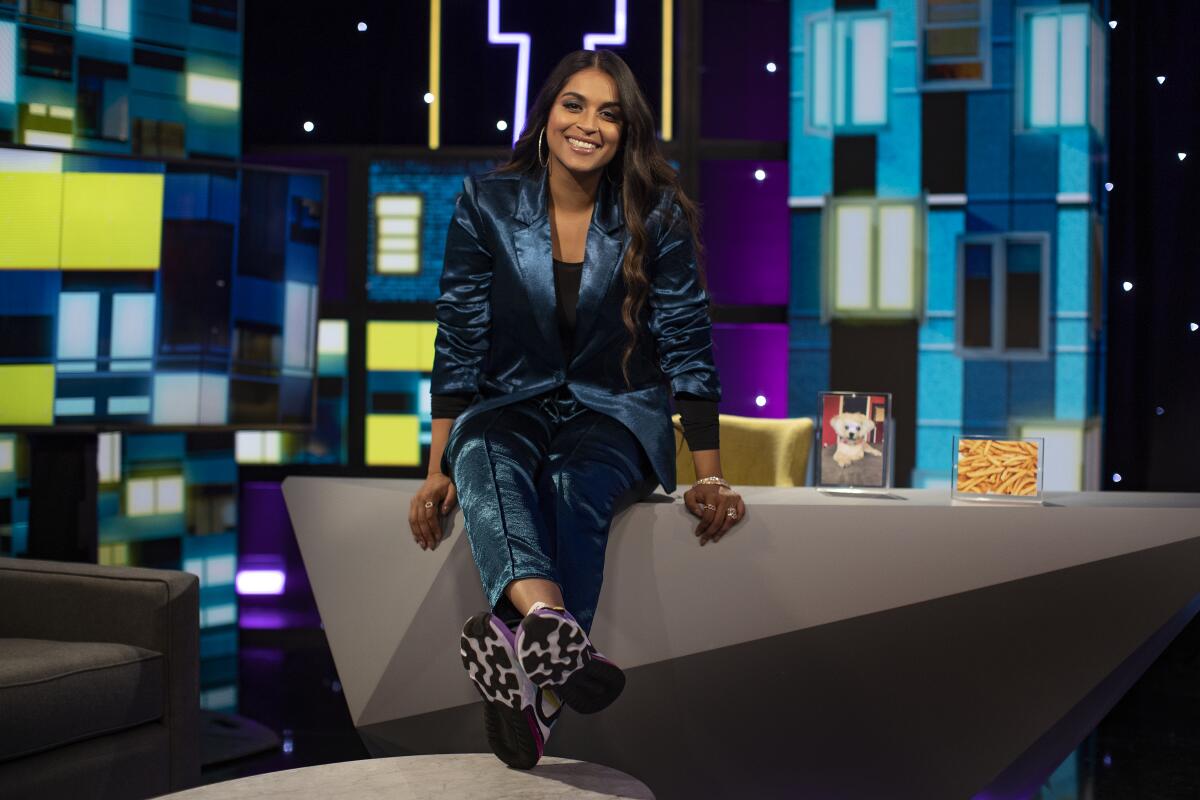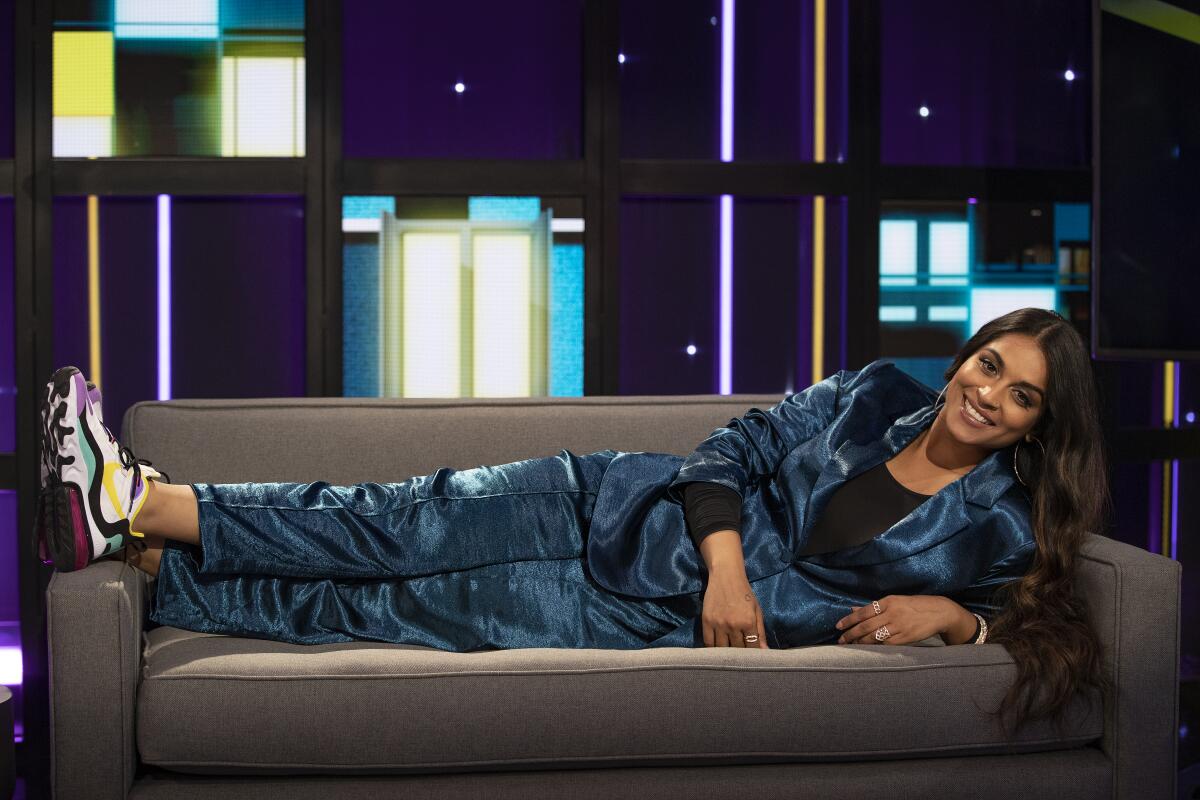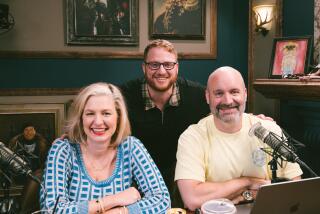Middle America may not get late-night newcomer Lilly Singh. They can deal with it

- Share via
When YouTube superstar Lilly Singh decided to join NBC’s late-night block — in the sleepless 1:35 a.m. slot previously held by Carson Daly — she kept the secret for months. She didn’t tell friends; she didn’t tell family. They learned about it, like most people, through the glittery unveiling on “The Tonight Show Starring Jimmy Fallon” in mid-March.
“I didn’t believe it and I didn’t want to jinx it,” says Singh. “I just didn’t think it would actually come to fruition. You have to understand, this seemed outside the realm of possibility for me.”
For the record:
1:56 p.m. Sept. 17, 2019A previous version of this story incorrectly identified the year Cynthia Garrett hosted the late-night talk show “Later.” She debuted as host in 2000, not 1999.
Singh, 30, was born in Canada to Indian immigrants and became a digital A-lister — with nearly 15 million subscribers — thanks to her online persona “|| Superwoman ||” and funny observational videos, including her take on “Types of Parents” and “How to Be the Perfect Brown Person.” Now, mainstream stardom is firmly within the realm of possibility. And she’s making history to boot.

With the launch of “A Little Late With Lilly Singh” on Monday night (or the wee hours of Tuesday morning, to be precise), she joins the tiny cadre of women who’ve helmed network late-night talkers: Joan Rivers briefly hosted “The Late Show” on Fox in the mid-1980s, and former VH1 VJ Cynthia Garrett led NBC’s “Later” for a year beginning in 2000. Including the cable networks, she’ll be one of only two women currently in late night — the other is Samantha Bee, host of TBS’ “Full Frontal.” Singh is also the first openly bisexual woman of color to host a talk show. But while she’s fully aware of the significance of all that — acknowledging it in an early version of her show’s first monologue — she tries not to be weighed down by it.
“I’m not getting too ahead of myself in terms of, like, ‘Oh my God, this is such a big deal,’” Singh says. “It’s too easy to get caught up in all that. I’m just really in the moment. My focus is on making sure the script of today’s show is funny.”
It’s 9 a.m. on a recent weekday and Singh is seated cross-legged on the couch in her sparsely decorated office in L.A., the focal point of which are framed posters from Paper Samosa that fuse Indian comedic touches with Western pop culture. Dressed in a black sweatsuit, Singh apologizes for her groggy voice. She’s in the grind of the first week of tapings, fast on the heels of a series of test shows.
She describes her initial hesitation about doing “A Little Late,” concerned about what the commitment would mean for her personal and professional lives. The fame she amassed with her irreverent YouTube videos led to a world tour, brand partnerships with the likes of Coca-Cola and Skittles, and appearances in films and TV shows such as “Bad Moms” and “Life in Pieces.” It also fueled the launch of her own company, Unicorn Island Productions. But it left her burned out, prompting a brief hiatus from videos late last year to focus on her mental health.
“It took me a while to think about it,” says Singh, who moved to Los Angeles a few years ago. “This is something that consumes a lot of your life. But one, I was scared. And usually when I’m scared, it’s a good thing. And two, it was something that I never thought would be possible for someone like me and I didn’t want that thinking to continue. I wanted to lean in. I wanted to be part of paving the path for others.”
In the movie “Late Night,” which opened in limited release Friday, Mindy Kaling plays Molly Patel, a woman plucked from obscurity to help revitalize a long-running but creatively stagnant late-night show.

Meanwhile, NBC executives saw the benefits of breaking up the very white, very male monotony of broadcast late night and enlisting a digital native as host — much of the format’s relevance is now as tied to the social chatter it generates as the Nielsen numbers it pulls in.
“If you look across the late-night landscape on broadcast, there are obvious deficiencies in terms of inclusion,” says NBC Entertainment co-chairman Paul Telegdy. “It’s fair to say that [we] were looking for someone who would be different to the others we had at the time period.”
“[W]e use this 1:35 a.m. slot as a creative playground for someone to build a show that we know isn’t a linear ratings play — this is a relevancy play, this is a digital play,” adds George Cheeks, who shares the co-chairman title with Telegdy. “What was clear to both of us is that [Singh] is a star and that whatever platform you put her on, she will excel.”
Singh isn’t the first YouTube sensation to make the jump to more traditional avenues: Grace Helbig, a friend of Singh’s, brought her funny and awkward humor to E! Network, where she fronted a talk show after Chelsea Handler’s departure. (The show lasted one season.)
Even though she’s never done this before, there also isn’t a single aspect of this that she hasn’t done in some way.
— Aliyah Silverstein, showrunner of “A Little Late with Lily Singh”
Singh understands the potential perils of Hollywood’s outsized expectations when it comes to YouTube personalities.
“Whether it’s networks, whether it’s a brand, whatever it is, they want the person’s following, and they want the person — but then they don’t want the person,” she says. “They’re trying to take someone and then change them. And that’s where the problem is. The reason us creators are so successful on YouTube is because we’re very authentic. We are who we are. And when you go into network TV and there’s a bunch of people telling you how you should be, there’s a reason that doesn’t work.”
It’s something she’s mindful of in the process of fine-tuning “A Little Late,” down to the smallest details. While rehearsing a monologue the previous week, she requests that certain words on the teleprompter be changed to their Canadian spelling (“favorite” becomes “favourite”) so she can feel “more in her element,” and eliminates others that don’t sound true to her voice. When executive producer John Irwin questions whether a graphic illustrating what a rebooted TV show would look like with an all-Indian cast will translate for an audience unfamiliar with the faces in the rendering, Singh pushes back.
“I want my show to be for everyone,” she explains later. “And I know sometimes my jokes can tend to lean into more Indian things because that’s my experience. And I don’t want to isolate an audience that won’t understand that. But at the same time, I have been raised in an environment where I’ve dealt with that. I grew up with comedy that I couldn’t relate to at all. But I enjoyed it, and it was funny. So I just don’t agree when people are like, ‘Middle America is not going to get this.’ They can deal with it. They will never get it if we don’t show it to them. And if they don’t get one joke that a lot of Indians will, that’s fine.”
Though “A Little Late” will feature typical talk-show elements — a monologue, comedy bits and guests, including Mindy Kaling, Kenan Thompson, Tracee Ellis Ross and Handler in its first week — the 96-episode first season will be taped, two shows per night four nights a week, over the next three months. As such, the show’s monologues won’t necessarily be peppered with jokes on current events, Irwin says. Instead, they’ll lean toward Singh’s first-person account of the topic at hand. She sends lengthy voice notes to the writers to help them craft the monologue in her style. One staple of late night these days that won’t get too much air time on “A Little Late”? Politics.
“Right out of the gate, she said, ‘I do not want to do politics, I do not want to get up there and talk about Donald Trump or any of that stuff. I want to be fun and funny and inclusive,” says Irwin, who worked for years on “Late Night With Conan O’Brien.” “That was such a breath of fresh air.”
Adds Singh: “In the playing field of late night, there’s so many people that comment on politics so well already and it’s authentic to them. What I’m going to give is social commentary. I might not talk about a politician, but will I talk about something that affects women’s bodies? For sure.”
Showrunner Aliyah Silverstein (“Hollywood Game Night,” “Hell’s Kitchen”) says Singh’s background as a YouTube personality has reduced much of the troubleshooting of launching a talk show.
“I feel like she’s light years ahead of someone newly launching a show, because there’s usually so much that you need to figure out — who am I on camera? What’s my character? What are the things I care about?” Silverstein says. “She comes to this process already having thought about an answer to those questions ... even though she’s never done this before, there isn’t a single aspect of this that she hasn’t done.”
I wanted to be part of paving the path for others.
— Lilly Singh
Not that there hasn’t been a learning curve. Singh admits that adhering to the time limits of segments and learning camera cues has been an adjustment. “It gets real when they’re like ’30 seconds left,’” Singh says. “It’s different than my vlog, where I can do whatever I want.” And dealing with broadcast standards and practices is a new experience — “I don’t deal with that on my YouTube channel. And sometimes I get a little stubborn about things.”
For example, it was originally suggested that Singh do a wardrobe fitting for all 96 shows in one session and she resisted; similarly, she declined a suggestion that the turnaround time between tapings should be 15 minutes.
“I’m learning,” Singh says. “And look, I’m going to play the game to change the game. ... This is a late-night world that’s been dominated by black and blue suits. So it’s been a bit of a learning curve for other people on what it means to have a woman host.”
Better late than never.
More to Read
The complete guide to home viewing
Get Screen Gab for everything about the TV shows and streaming movies everyone’s talking about.
You may occasionally receive promotional content from the Los Angeles Times.







